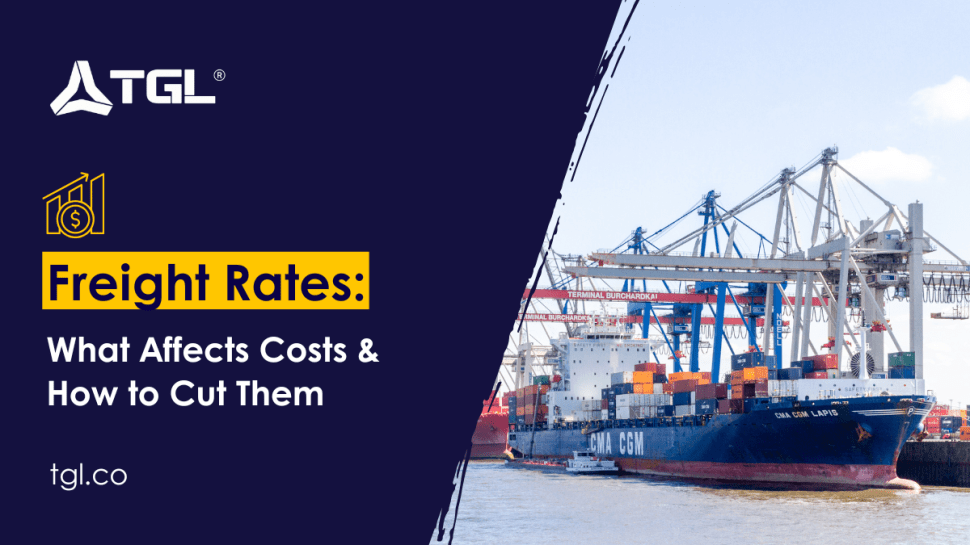Introduction
Freight rates can be confusing, fluctuating with little warning and often leaving businesses unsure of what they’re actually paying for. Whether you’re importing or exporting, understanding the factors that affect shipping costs is key to controlling your logistics spending. In this guide, we break down what drives freight rates and share actionable tips on how to reduce them.
What Are Freight Rates?
Freight rates refer to the price charged for transporting goods from one location to another. These rates depend on several variables, including distance, cargo type, and current market conditions. Understanding them is the first step to managing your logistics more effectively.
6 Key Factors That Affect Freight Shipping Costs
If you’ve ever wondered why your quote changes from week to week, here are the main drivers behind freight rates:
-
Fuel Costs
Fuel surcharges are directly linked to global oil prices. As fuel becomes more expensive, shipping costs rise, especially for long-haul freight. -
Shipping Distance and Route Efficiency
The longer the shipping distance, the higher the cost. But routes matter too. High-volume trade lanes may be cheaper, while niche or complex routes often cost more due to limited carrier options. -
Mode of Transportation (Sea, Air, Road)
Sea freight is cost-effective for bulk cargo but slower.
Air freight is faster but significantly more expensive.
Road transport adds variability depending on fuel, tolls, and distance. -
Cargo Type, Weight & Volume
Heavier or bulkier shipments cost more. Special cargo like temperature-sensitive, hazardous, or oversized items requires extra care, raising costs. -
Shipping Seasonality
During peak shipping seasons (like pre-holiday periods), rates rise due to high demand and limited container availability. -
Customs and Port Charges
These include terminal handling fees, documentation costs, and import/export duties. They vary depending on country, port, and cargo type.
The Importance of Carrier Relationships and Contract Negotiations
One often underestimated way to reduce freight costs is by fostering strong relationships with carriers and freight forwarders. Regular shippers who maintain consistent volumes are in a better position to negotiate rates, gain access to priority space, and receive favorable terms. Instead of relying solely on spot rates, consider establishing long-term contracts that lock in pricing and protect against market volatility. Think Global Logistics can help you evaluate when it’s best to go spot vs. contract and manage negotiations to your advantage.
Leverage Data and Analytics
Modern logistics decisions shouldn’t rely on guesswork. By analyzing past shipments, businesses can uncover patterns such as peak rate periods, recurring delays, or costly inefficiencies. With this information, you can optimize shipment timing, choose better routes, or switch service providers when necessary. At Think Global Logistics, we support clients by offering reporting dashboards and performance insights to make more informed, cost-effective logistics decisions.
How to Reduce Freight Shipping Costs: 5 Pro Tips
Lowering freight rates isn’t just about finding the cheapest quote. It’s about optimizing your entire shipping strategy:
-
Book in Advance
Advance bookings allow access to better rates, especially for sea freight. Avoid the last-minute surcharge trap. -
Consolidate Your Cargo
Combining shipments through LCL (less-than-container load) or groupage can lower costs and improve efficiency. -
Use a Trusted Freight Forwarder
Experienced logistics providers like Think Global Logistics can negotiate better rates, find optimal routes, and help you avoid unnecessary fees. -
Be Transparent with Cargo Details
Accurate dimensions, weights, and cargo descriptions help avoid surprise charges and ensure smooth customs clearance. -
Review Your Incoterms
Choosing the right Incoterm (like FOB, CIF, EXW) can shift cost responsibilities and reduce your overall expenses.
Why Work with Think Global Logistics?
At Think Global Logistics, we don’t just quote freight rates, we explain them. Our team works closely with you to tailor freight solutions that balance cost, speed, and reliability. Whether you’re shipping by sea, air, or land, we provide end-to-end visibility and support across every stage of your supply chain.
Conclusion
Freight rates are influenced by global trends, seasonal shifts, and operational logistics. While you can’t control everything, you can make smarter shipping decisions. By understanding what drives freight costs and working with the right logistics partner, your business can ship smarter and save more.
Need help understanding freight rates?
Contact Think Global Logistics today for a transparent quote and expert guidance on managing your shipping costs.
